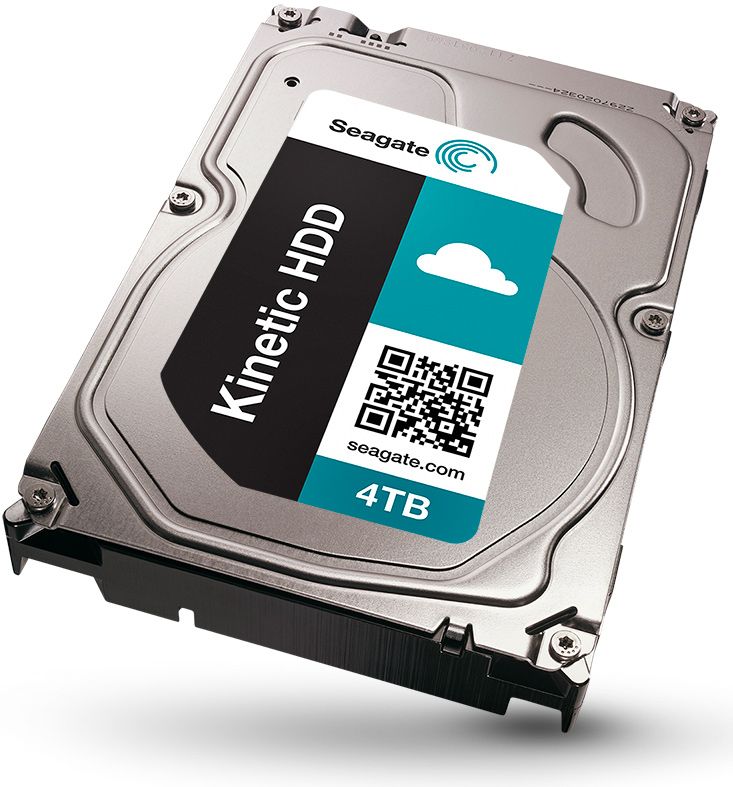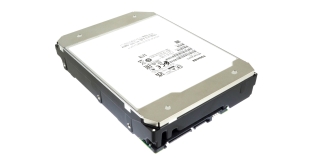Seagate Technology has introduced its first Kinetic-series hard disk drives for cloud storage applications. The Kinetic HDDs come with their own built-in operating system and can be plugged directly to Ethernet ports, thus, eliminating multiple layers of legacy software and hardware infrastructure.
Seagate Kinetic hard drive features 4TB capacity, dual SGMII Ethernet 1Gb/s ports, an application processor, 512MB of RAM, 64MB of cache as well as its own micro operating system that is a part of Kinetic Open Storage platform. The micro-OS manages storage media space itself and does not require any legacy file system or even a host server, which greatly simplifies modern storage platforms. Since every Kinetic hard drive is essentially a micro-server, storage applications now need to “talk” directly to Kinetic object storage HDDs, not to host servers. Performance is further enhanced by eliminating storage server bottlenecks via direct IP addressing of each drive, thereby improving system level throughput.
According to Seagate, its Kinetic platform (and Kinetic HDD) enables servers and storage to be scaled independently and developed more rapidly. Cloud data centers can add servers and storage at entirely different rates, matching each precisely to their needs. This reduces TCO, improves performance and adds flexibility. Moreover, this lets Seagate to incorporate future HDD innovations without host software changes as servers and operating systems are shielded from device changes through the Kinetic open source API.
“Over the past decade, the unprecedented explosion of data has been driven by social media, smartphones, tablets, and the rapid growth of every sort of Internet-connected device,” said Scott Horn, Seagate vice president of marketing. “Cloud service providers (CSPs) are increasingly looking for solutions that will simplify infrastructure, improve scalability and reduce costs— Kinetic HDD addresses these needs revolutionizing the data storage economics for today’s cloud and beyond.”
Seagate’s Kinetic open storage platform is currently supported by multiple CSPs and hardware manufacturers, including AOL, Hewlett-Packard, Digital Sense, Internet Initiative Japan, Supermicro, SwiftStack and many others.
Discuss on our Facebook page, HERE.
KitGuru Says: Seagate’s Kinetic platform makes a lot of sense for datacentres that require massive amounts of storage as well as ability to quickly add storage capacities once needed. Basically speaking, the majority of future datacentres will benefit from the flexible approach Seagate offers. Of course, not all CSPs will transit to Seagate’s platform, but the technology itself makers a great sense.
 KitGuru KitGuru.net – Tech News | Hardware News | Hardware Reviews | IOS | Mobile | Gaming | Graphics Cards
KitGuru KitGuru.net – Tech News | Hardware News | Hardware Reviews | IOS | Mobile | Gaming | Graphics Cards




Certainly an interesting way to build network drives, literally. It would be even cooler if this could be done with SSDs. I’m assuming that it may be possible to install an operating system and boot from this drive when connected via Ethernet, but I wouldn’t know, since I don’t have this product.
Certainly an interesting way to build network drives, literally. It would be even cooler if this could be done with SSDs. I’m assuming that it may be possible to install an operating system and boot from this drive when connected via Ethernet, but I wouldn’t know, since I don’t have this product.
Probably not idea loading the os from a network, as it loads it would need to send each file indivually, this will produce quite an over head and will take longed than an internal ssd over sata or PCIE
Interesting in SOHO/home application. But very limited
LAN networking isn’t the worst idea, but like you said, it’s probably not ideal.
LAN networking isn’t the worst idea, but like you said, it’s probably not ideal.
It would be REALLY cool if they were 10gbps ports and you could team the drives together to make a RAID5 somehow with the redundant ports… it could be an ever expanding “Live” drive that could sit in a cheap rack somewhere and act as back-up for an entire premise.
It would be REALLY cool if they were 10gbps ports and you could team the drives together to make a RAID5 somehow with the redundant ports… it could be an ever expanding “Live” drive that could sit in a cheap rack somewhere and act as back-up for an entire premise.
Ahh but if you have a deduplication system in place or optimisation tool it will only need to load one copy of each OS on your network. Veeam does it and so does SimpliVity.
kinetic SSD, please.
What is the price of a 4TB disk? It is 2015 and that information is not widely available…